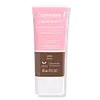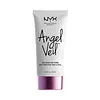What's inside
What's inside
 Key Ingredients
Key Ingredients

 Benefits
Benefits

 Concerns
Concerns

No concerns
 Ingredients Side-by-side
Ingredients Side-by-side

Water
Skin ConditioningCyclopentasiloxane
EmollientGlycerin
HumectantPhenyl Trimethicone
Skin ConditioningTrimethylsiloxysilicate
EmollientAcetyl Glucosamine
Skin ConditioningNiacinamide
SmoothingSodium Chloride
MaskingAluminum Starch Octenylsuccinate
AbsorbentPEG/PPG-18/18 Dimethicone
EmulsifyingMica
Cosmetic ColorantAmmonium Acrylates Copolymer
Phenoxyethanol
PreservativeTocopheryl Acetate
AntioxidantPanthenol
Skin ConditioningCaprylyl Glycol
Emollient1,2-Hexanediol
Skin ConditioningSodium Benzoate
MaskingAlcohol Denat.
AntimicrobialDimethicone
EmollientMethicone
EmollientDisodium Deceth-6 Sulfosuccinate
CleansingTocopherol
AntioxidantLaureth-30
CleansingCocos Nucifera Oil
MaskingGlycine Soja Oil
EmollientAloe Barbadensis Leaf Juice
Skin ConditioningSodium Dehydroacetate
PreservativePentylene Glycol
Skin ConditioningCocos Nucifera Fruit Extract
EmollientPEG-60 Hydrogenated Castor Oil
EmulsifyingCitric Acid
BufferingFructose
HumectantSodium Hydroxide
BufferingUrea
BufferingAllantoin
Skin ConditioningMaltose
MaskingSodium Lactate
BufferingSodium PCA
HumectantTrehalose
HumectantPhenethyl Alcohol
MaskingPotassium Sorbate
PreservativeGlucose
HumectantSilybum Marianum Seed Extract
Skin ConditioningSodium Hyaluronate
HumectantHelianthus Annuus Seed Oil
EmollientRosmarinus Officinalis Leaf Extract
AntimicrobialLimonene
PerfumingLinalool
PerfumingCI 77891
Cosmetic ColorantIron Oxides
Water, Cyclopentasiloxane, Glycerin, Phenyl Trimethicone, Trimethylsiloxysilicate, Acetyl Glucosamine, Niacinamide, Sodium Chloride, Aluminum Starch Octenylsuccinate, PEG/PPG-18/18 Dimethicone, Mica, Ammonium Acrylates Copolymer, Phenoxyethanol, Tocopheryl Acetate, Panthenol, Caprylyl Glycol, 1,2-Hexanediol, Sodium Benzoate, Alcohol Denat., Dimethicone, Methicone, Disodium Deceth-6 Sulfosuccinate, Tocopherol, Laureth-30, Cocos Nucifera Oil, Glycine Soja Oil, Aloe Barbadensis Leaf Juice, Sodium Dehydroacetate, Pentylene Glycol, Cocos Nucifera Fruit Extract, PEG-60 Hydrogenated Castor Oil, Citric Acid, Fructose, Sodium Hydroxide, Urea, Allantoin, Maltose, Sodium Lactate, Sodium PCA, Trehalose, Phenethyl Alcohol, Potassium Sorbate, Glucose, Silybum Marianum Seed Extract, Sodium Hyaluronate, Helianthus Annuus Seed Oil, Rosmarinus Officinalis Leaf Extract, Limonene, Linalool, CI 77891, Iron Oxides
Ingredients Explained
These ingredients are found in both products.
Ingredients higher up in an ingredient list are typically present in a larger amount.
Caprylyl Glycol is a humectant and emollient, meaning it attracts and preserves moisture.
It is a common ingredient in many products, especially those designed to hydrate skin. The primary benefits are retaining moisture, skin softening, and promoting a healthy skin barrier.
Though Caprylyl Glycol is an alcohol derived from fatty acids, it is not the kind that can dry out skin.
This ingredient is also used as a preservative to extend the life of products. It has slight antimicrobial properties.
Learn more about Caprylyl GlycolCyclopentasiloxane, or D5, is a silicone used to improve texture of products and trap moisture.
D5 is considered lightweight and volatile. Volatile means it evaporates quickly after application. Once evaporated, D5 leaves a thin barrier that helps keep skin hydrated.
It is also an emollient. Emollients help soften the skin and prevent water loss. Silicones create a silky texture in products. D5 helps other ingredients become more spreadable.
Studies show D5 is safe to use in skincare products. We recommend speaking with a skincare professional if you have concerns.
Learn more about CyclopentasiloxanePhenoxyethanol is a preservative that has germicide, antimicrobial, and aromatic properties. Studies show that phenoxyethanol can prevent microbial growth. By itself, it has a scent that is similar to that of a rose.
It's often used in formulations along with Caprylyl Glycol to preserve the shelf life of products.
Tocopherol (also known as Vitamin E) is a common antioxidant used to help protect the skin from free-radicals and strengthen the skin barrier. It's also fat soluble - this means our skin is great at absorbing it.
Vitamin E also helps keep your natural skin lipids healthy. Your lipid skin barrier naturally consists of lipids, ceramides, and fatty acids. Vitamin E offers extra protection for your skin’s lipid barrier, keeping your skin healthy and nourished.
Another benefit is a bit of UV protection. Vitamin E helps reduce the damage caused by UVB rays. (It should not replace your sunscreen). Combining it with Vitamin C can decrease sunburned cells and hyperpigmentation after UV exposure.
You might have noticed Vitamin E + C often paired together. This is because it is great at stabilizing Vitamin C. Using the two together helps increase the effectiveness of both ingredients.
There are often claims that Vitamin E can reduce/prevent scarring, but these claims haven't been confirmed by scientific research.
Learn more about TocopherolWater. It's the most common cosmetic ingredient of all. You'll usually see it at the top of ingredient lists, meaning that it makes up the largest part of the product.
So why is it so popular? Water most often acts as a solvent - this means that it helps dissolve other ingredients into the formulation.
You'll also recognize water as that liquid we all need to stay alive. If you see this, drink a glass of water. Stay hydrated!
Learn more about Water